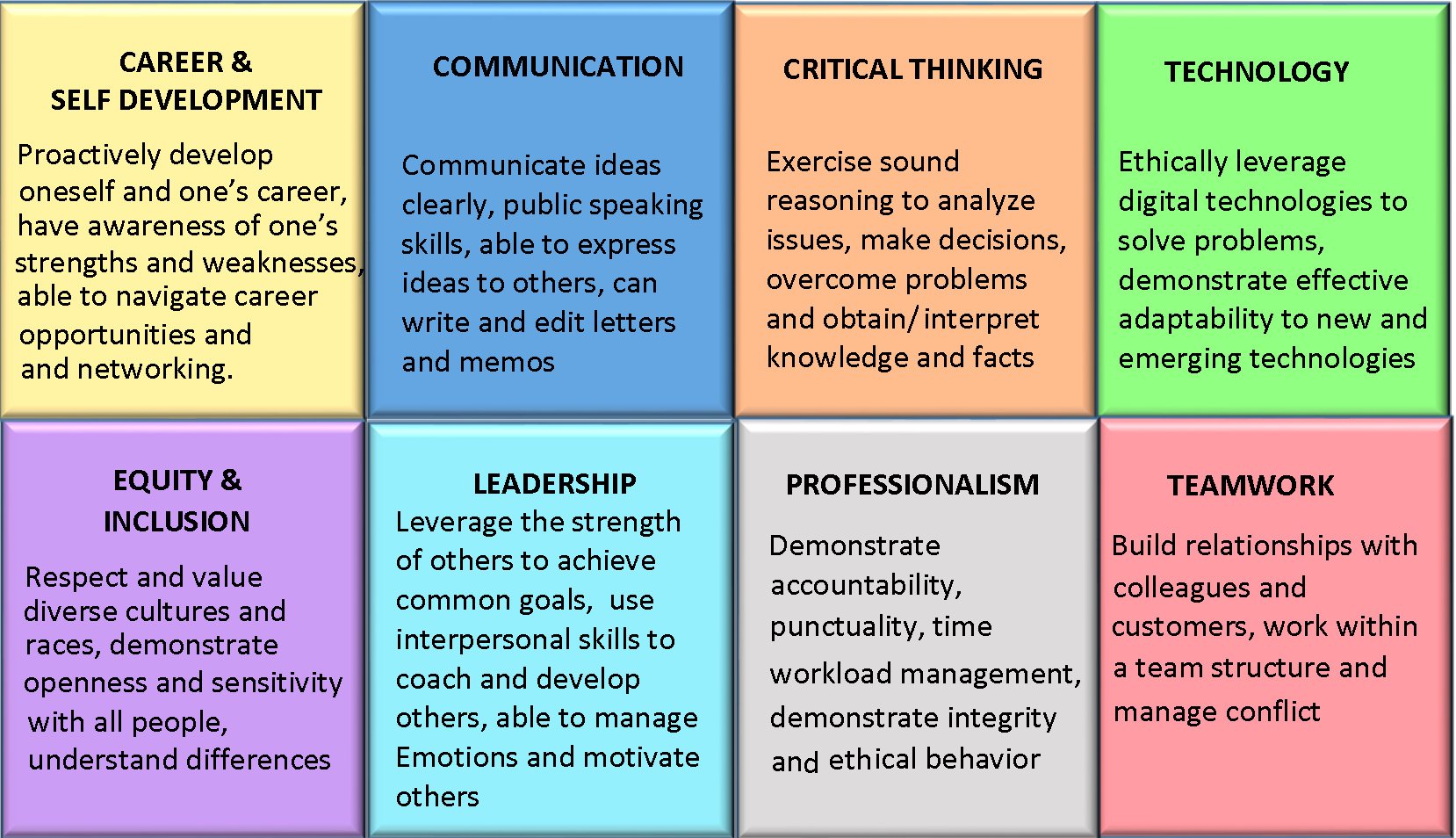7.1: Soft Skills and Career Readiness
- Page ID
- 147023
Year after year on national surveys, employers rank soft skills as even more essential than hard skills for career success.
What are Soft Skills?
The best way to understand soft skills is to compare them to hard skills. Hard skills are technical or practical skills such as accounting, computer repair, and other practices or techniques you learn in courses in your college major, in a practicum, or on the job. Soft skills are personal and interpersonal attributes that are important no matter what job or position you are hired for. Soft skills are considered “transferrable skills” because they are relevant for any position and can be transferred from one job to another. Employers look for soft skills because these skills are difficult and time-consuming to teach yet are important to success. Figure \(\PageIndex{1}\) compares soft and hard skills.
|
SOFT SKILLS |
HARD SKILLS |
|
| What are they? | personal attributes and interpersonal abilities | practical abilities and skills usually learned through practice and education |
| What are some examples? | communication, professionalism, teamwork, problem-solving, respect for others, leadership | computer repair, accounting, Excel, Python, AutoCAD, social media marketing, graphics manufacturing, CPR, rescue equipment |
| Why are they important? | helps you get the job | helps you get an interview |
Soft Skills Examples for Students
Students or recent graduates often find themselves looking for a job without work experience. You can still find plenty of soft skills from your educational background that your can discuss in a job interview or career fair. Some of these include teamwork, critical thinking, organization, research, public speaking, self-motivation, dependability, empathy, enthusiasm, diplomacy, planning, reliability, leadership, self-awareness, resourcefulness, patience, persuasion, interpersonal skills. Think about ways you can discuss your command of these soft skills by giving examples of times you have learned and demonstrated these skills in specific courses; in your volunteer work; or in your involvement in clubs and organizations.
Soft Skills in the Job Search Process and Interview
Employers may value different soft skills according to the specific position you are applying for. How do you know which soft skills are valued by the employer? The answer to this lies 1) in what you have learned in your research about the company and in 2) the job description. When you read the job description, you will likely see statements such as, "Must be able to work independently as well as as part of a team" or "must show diplomacy and sensitivity in dealing with others." These are the soft skills you must be able to address in your interview, on the cover letter, and, to a lesser extent, on the resume. To prepare for the job interview, be able to address specific soft skills and how you have developed them. Another way you can demonstrate your soft skills are through the job interview itself. To demonstrate your soft skills during the interview
- refer to your research and what you have learned about the company
- demonstrate your critical thinking and active listening skills by replying specifically to questions asked in the interview
- demonstrate your planning by showing you have prepared for questions during the interview; don't allow questions to take you by surprise
Career Competencies
Eight Essential Career Competencies
As first discussed in Chapter 1, the National Association of Colleges and Employers identified eight essential career competencies. These essential competencies are career and self-development; communication; critical thinking; technology; equity and inclusion; leadership; professionalism; and teamwork. Each is explained in the figure shown below.

Source: "10 Steps to Career Development Success," Adapted from the National Association of Colleges and Employers (NACE) Career Readiness Competencies by Southwest Tennessee Community College's Career Services Department.
How "Career Ready" is the Typical College Graduate?
According to the National Association of Colleges and Employers, "When it comes to rating the 'career readiness' of college graduates . . . employers tend to rate the proficiency of recent college graduates lower than do the students themselves. This can be problematic because it suggests that employers see skills gaps in key areas where college students don’t believe gaps exist. . . Employers and graduating seniors differed greatly when it came to rating proficiency in competencies such as professionalism/work ethic, oral/written communications, and leadership as students considered themselves much more proficient than did employers." (NACE) The results are shown in Figure \(\PageIndex{3}\).
| COMPETENCY | % OF EMPLOYERS THAT RATED RECENT GRADS PROFICIENT* | % OF STUDENTS WHO CONSIDERED THEMSELVES PROFICIENT** |
|---|---|---|
| Professionalism/Work Ethic | 42.5% | 89.4% |
| Oral/Written Communications | 41.6% | 79.4% |
| Critical Thinking/Problem Solving | 55.8% | 79.9% |
| Teamwork/Collaboration | 77.0% | 85.1% |
| Leadership | 33.0% | 70.5% |
| Digital Technology | 65.8% | 59.9% |
| Career Management | 17.3% | 40.9% |
| Global/Intercultural Fluency | 20.7% | 34.9% |
Developing Career Readiness Competencies
As you have likely already noticed, many of these competencies are components of your Fundamentals of Communication course. In addition to Oral and Written Communication, you will be or have already been introduced to Global and Intercultural Fluency (Equity and Inclusion), Teamwork/Collaboration, Leadership, and Critical Thinking/Problem-Solving. In this chapter, you will learn about another important career competency: professionalism. In addition, you will take steps toward Career Management.
As you develop your career competencies, a great place to keep track of your accomplishments is in an e-Portfolio or digital portfolio.
What is an E-Portfolio?
A digital portfolio is a computer-based collection of student performance over time. Digital portfolios can include many different types of content, including photographs, texts, illustrations, graphic design projects, artwork, papers you've written, and speeches you've given. You should build your e-Portfolio over time, adding new content each semester and after graduation to record your new experiences, projects, and activities.
Uses of an e-Portfolio
An e-Portfolio can be used to apply for scholarships and internships and to gain admissions to a four-year university or master's degree programs. Another important use of a digital portfolio can be in your search for employment. Submitting a link to your digital portfolio along with your resume and cover letter provides an online source of information that helps set you apart from other candidates and may improve your chances of getting an interview. "If you want to show an employer proof of your skills and abilities, then a digital portfolio is an excellent way to display your work and show hiring managers what you are capable of doing. Having a visual representation of your qualifications also helps employers decide if you are the right fit for their company and position." (Indeed.com) Aside from its academic and professional uses, an e-Portfolio can be personally satisfying because you can share your experiences with friends and family and look back over your activities in the future.
Starting Your E-Portfolio
Although many platforms exist for developing digital portfolios, Google is a good option since most students already have an account. To start an e-Portfolio on Google, visit https://www.southwest.tn.edu/career-services/docs/e-portfolio.pdf for instructions, then complete the steps. Set up your e-Portfolio title page and create titles for additional content pages. Suggested additional e-Portfolio page categories: 1. About me. 2. Career assessment information (from Career Coach) 3. Resume (from Optimal Resume) 4. Class projects (recorded speeches, photos of artwork or other projects) 5. Activities (such as club membership, etc.). For more information or questions about e-Portfolios, contact Career Services at careerservices@southwest.tn.edu.
Career Services at Southwest Tennessee Community College
This unit of the course is presented in collaboration with Career Services Director Brenda Williams and the Career Services Department at Southwest Tennessee Community College. Much of the content of this chapter is taken from the digital guide created by Career Services, Career Development at Southwest. You can access the guide in its entirety at https://www.southwest.tn.edu/career-services/docs/Career-Development-Guide.pdf.

References
Career Services. Southwest Tennessee Community College. Career Development at Southwest. 2021. https://www.southwest.tn.edu/career-services/docs/Career-Development-Guide.pdf
"How to Make a Digital Portfolio That Gets You Hired." Indeed.com. 22 Feb. 2021. https://www.indeed.com/career-advice...ital-portfolio
"Are College Graduates Career Ready?" National Association of Colleges and Employers (NACE). 19 Feb. 2018. https://www.naceweb.org/career-readiness/competencies/are-college-graduates-career-ready/.
U.S. Department of Labor. Office of Disability Employment Mastering Soft Skills for Workplace Success. “Professionalism.’ Retrieved 12/15/2020. https://www.dol.gov/sites/dolgov/files/odep/topics/youth/softskills/softskills.pdf


